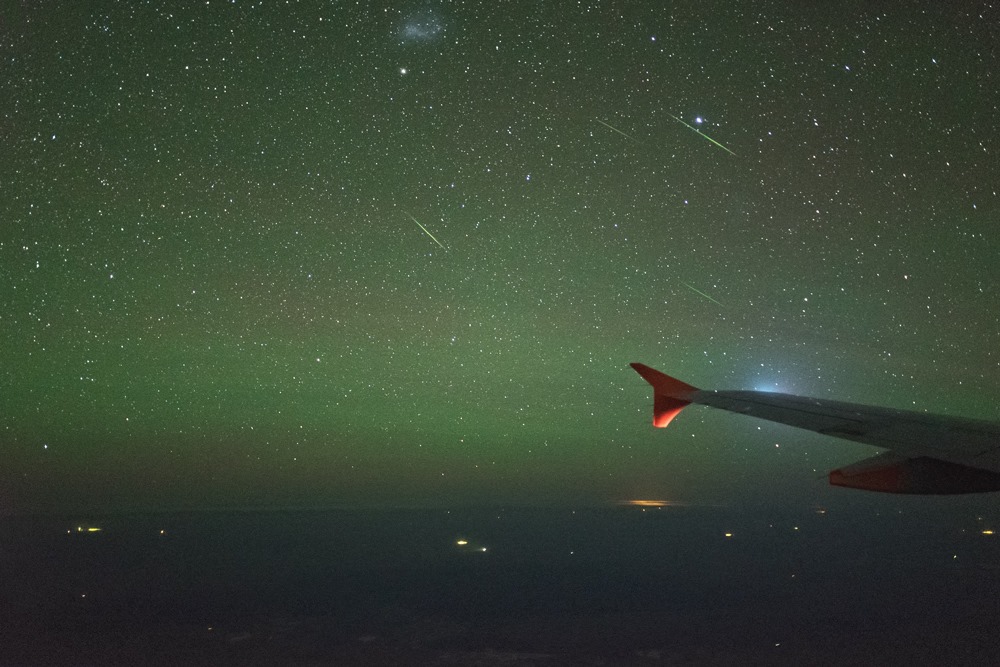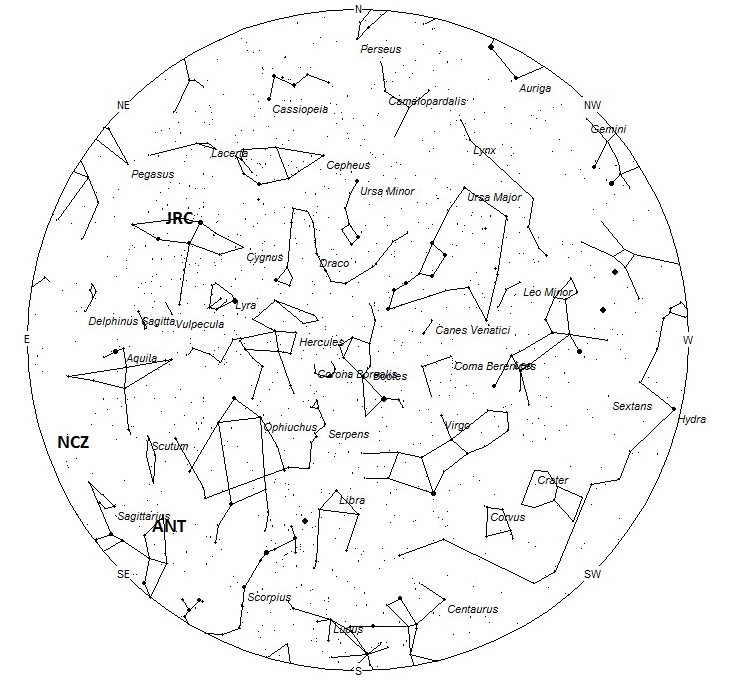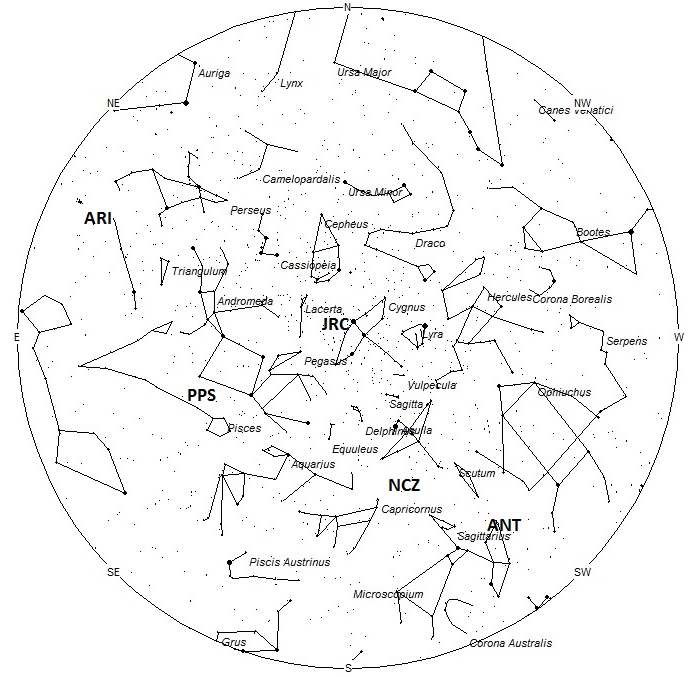
Alpha Centaurid Meteor Shower at 40,000 ft by Colin Legg Photography – between 10:50 and 11:10 pm WST, Feb 14 2015 – Western Australia
During this period the moon reaches its new phase on Tuesday June 16th. At this time the moon will be located near the sun and will be invisible at night. This upcoming weekend the waning crescent moon will rise just before the onset of dawn and will not interfere with meteor observing. The estimated total hourly meteor rates for evening observers this week is near 3 for observers situated at mid-northern latitudes and 4 for observers viewing from the southern tropics (latitude 25 S.). For morning observers the estimated total hourly rates should be near 9 for observers situated at mid-northern latitudes and 12 for observers viewing from the southern tropics. The actual rates will also depend on factors such as personal light and motion perception, local weather conditions, alertness and experience in watching meteor activity. Note that the hourly rates listed below are estimates as viewed from dark sky sites away from urban light sources. Observers viewing from urban areas will see less activity as only the brightest meteors will be visible from such locations.
The radiant (the area of the sky where meteors appear to shoot from) positions and rates listed below are exact for Saturday night/Sunday morning June 13/14 These positions do not change greatly day to day so the listed coordinates may be used during this entire period. Most star atlases (available at science stores and planetariums) will provide maps with grid lines of the celestial coordinates so that you may find out exactly where these positions are located in the sky. A planisphere or computer planetarium program is also useful in showing the sky at any time of night on any date of the year. Activity from each radiant is best seen when it is positioned highest in the sky, either due north or south along the meridian, depending on your latitude. It must be remembered that meteor activity is rarely seen at the radiant position. Rather they shoot outwards from the radiant so it is best to center your field of view so that the radiant lies at the edge and not the center. Viewing there will allow you to easily trace the path of each meteor back to the radiant (if it is a shower member) or in another direction if it is a sporadic. Meteor activity is not seen from radiants that are located below the horizon. The positions below are listed in a west to east manner in order of right ascension (celestial longitude). The positions listed first are located further west therefore are accessible earlier in the night while those listed further down the list rise later in the night.
These sources of meteoric activity are expected to be active this week.
The center of the large Anthelion (ANT) radiant is currently located at 18:20 (275) -23. This position lies in western Sagittarius, 3 degrees northwest of the 3rd magnitude star known as Kaus Borealis (Lambda Sagittarii). Due to the large size of this radiant, Anthelion activity may also appear from eastern Scorpius, southern Serpens Cauda, and Scutum as well as Sagittarius. This radiant is best placed near 0100 Local Daylight Time (LDT), when it lies on the meridian and is located highest in the sky. Rates at this time should be near 2 per hour as seen from the northern hemisphere and 3 per hour as seen from south of the equator. With an entry velocity of 30 km/sec., the average Anthelion meteor would be of slow velocity.
The Northern June Aquilids (NCZ) were discovered by Zdenek Sekanina through his Radio Meteor Project at Havana, Illinois. These meteors are active from June 10-26, which maximum activity occurring on the 17th. The current position of the radiant is 19:41 (295) -11. This position lies in a remote area of southern Aquila near the Sagittarius border. The nearest notable star is 3rd magnitude Algiedi (Alpha Capricorni), which lies 8 degrees to the east. Rates, even at maximum, are expected to be less than 1 per hour. With an entry velocity of 41 km/sec., the average Northern June Aquilid meteor would be of medium speed.
The June Rho Cygnids (JRC) were discovered by Damir Šegon and associates of the Croatian Meteor Network. These meteors are only active for 3 nights centered on June 15th. The position of the radiant is 21:22 (320) +45. This position lies in northeastern Cygnus, 5 degrees east of the 1st magnitude star known as Deneb (Alpha Cygni). Rates at maximum are expected to be near 1 per hour as seen from the northern hemisphere. This shower is not well seen south of the equator. With an entry velocity of 48 km/sec., the average June Rho Cygnid meteor would be of medium speed. This shower is synonymous with shower #521 JRP in the IAU Meteor Catalog.
The Pi Piscids (PPS) were discovered by Dr. Peter Brown in his meteoroid stream survey using the Canadian Meteor Orbit Radar. This shower was later verified by Dr. Peter Jenniskens and David Holman using data from the CAMS network in northern California. These meteors are active from June 11 through July 25 with maximum activity occurring on July 2nd. The current position of the radiant is 00:04 (001) +11. This position lies in central Pisces, 5 degrees southwest of the 3rd magnitude star known as Algenib (Gamma Pegasi). Rates are currently expected to be less than 1 per hour no matter your location. With an entry velocity of 68 km/sec., the average Pi Piscid meteor would be of swift speed.
The radiant for the Daytime Arietids (ARI) only lies 45 degrees west of the sun. Therefore these meteors can only be seen between the time the radiant rises and dawn. This is a small window of opportunity that lasts for about an hour before the break of dawn. The exact position of the radiant is 03:24 (051) +24. This position lies in eastern Aries, 5 degrees west of the naked eye open cluster known as the Pleiades or M45. Despite being a strong source of meteors, visual members of this shower are rare due to the low altitude of the radiant. If this radiant was better placed in the sky it would rival the better known Perseids of August. These meteors are the strongest source of radio meteors for the entire year. With an entry velocity of 42 km/sec., the average Daytime Arietid meteor would be of medium speed.
As seen from the mid-northern hemisphere (45N) one would expect to see approximately 7 sporadic meteors per hour during the last hour before dawn as seen from rural observing sites. Evening rates would be near 2 per hour. As seen from the tropical southern latitudes (25S), morning rates would be near 9 per hour as seen from rural observing sites and 3 per hour during the evening hours. Locations between these two extremes would see activity between the listed figures.
The list below offers the information from above in a condensed form. Rates and positions are exact for Saturday night/Sunday morning.
| SHOWER | DATE OF MAXIMUM ACTIVITY | CELESTIAL POSITION | ENTRY VELOCITY | CULMINATION | HOURLY RATE | CLASS |
| RA (RA in Deg.) DEC | Km/Sec | Local Daylight Saving Time | North-South | |||
| Anthelions (ANT) | – | 18:20 (275) -23 | 30 | 01:00 | 2 – 3 | II |
| Northern June Aquilids (NCZ) | Jun 17 | 19:41 (295) -11 | 41 | 02:00 | <1 - <1 | IV |
| June Rho Cygnids (JRC) | Jun 15 | 21:22 (320) +45 | 48 | 04:00 | <1 - <1 | IV |
| Pi Piscids (PPS) | Jul 02 | 00:04 (001) +11 | 68 | 07:00 | <1 - <1 | IV |
| Daytime Arietids (ARI) | Jun 07 | 03:24 (051) +24 | 42 | 10:00 | <1 - <1 | II |
 American Meteor Society
American Meteor Society


